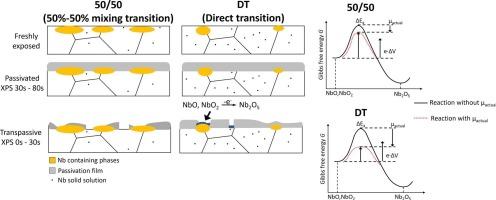不同混合制造策略增强了非均相LPBF SS316L-DED IN625界面的耐蚀性
IF 6.9
2区 材料科学
Q2 CHEMISTRY, PHYSICAL
引用次数: 0
摘要
混合激光增材制造将激光粉末床熔融(LPBF)和直接能量沉积(DED)相结合,将LPBF的精度与DED的灵活性相结合。虽然大多数研究都集中在力学性能上,但很少探索界面的腐蚀行为。本研究通过比较两种界面转变策略:直接转变(DT)和50 %-50 %混合转变(50/50),研究了LPBF不锈钢316L (SS316L)与DED Inconel 625 (IN625)混合制造界面的腐蚀行为。对界面微观结构、元素分布(特别是Nb)和钝化膜进行了表征,以阐明其腐蚀行为。结果表明,与50/50样品相比,Nb倾向于以固溶体的形式在DT界面积聚,而以含Nb相的形式析出的倾向较低。这种状态增强了Nb的扩散倾向,提高了其化学势,部分补偿了在高压阳极极化过程中进一步氧化成Nb2O5所需的活化能。因此,改善了钝化膜的完整性和二次钝化行为,从而提高了混合制造组件的耐腐蚀性。这项工作为通过先进增材制造系统中定制的混合制造策略优化耐腐蚀性提供了关键见解。本文章由计算机程序翻译,如有差异,请以英文原文为准。

Enhanced corrosion resistance at the heterogeneous LPBF SS316L-DED IN625 interface by different hybrid manufacturing strategies
Hybrid laser additive manufacturing, which combines laser powder bed fusion (LPBF) and direct energy deposition (DED), integrates the precision of LPBF with the flexibility of DED. While most studies have focused on mechanical performance, corrosion behavior at the interface has been rarely explored. This study investigates the corrosion behavior at the hybrid manufactured interface between LPBF stainless steel 316L (SS316L) and DED Inconel 625 (IN625) by comparing two interface transition strategies: direct transition (DT) and 50 %-50 % mixing transition (50/50). The interfacial microstructure, element distribution (particularly Nb), and passive film have been characterized to elucidate the corrosion behavior. Our results indicate that, compared to the 50/50 sample, Nb tends to accumulate at the DT interface predominantly in the form of solid solution and exhibits a lower tendency to precipitate as Nb-containing phases. This state enhances the diffusion tendency of Nb, raising its chemical potential and partially compensating for the activation energy required for further oxidation to Nb2O5 during anodic polarization under high voltage. Consequently, passive film integrity and secondary passivation behavior are improved, thus enhancing corrosion resistance of the hybrid-manufactured components. This work provides critical insights for optimizing corrosion resistance through tailored hybrid manufacturing strategies in advanced additive manufacturing systems.
求助全文
通过发布文献求助,成功后即可免费获取论文全文。
去求助
来源期刊

Applied Surface Science
工程技术-材料科学:膜
CiteScore
12.50
自引率
7.50%
发文量
3393
审稿时长
67 days
期刊介绍:
Applied Surface Science covers topics contributing to a better understanding of surfaces, interfaces, nanostructures and their applications. The journal is concerned with scientific research on the atomic and molecular level of material properties determined with specific surface analytical techniques and/or computational methods, as well as the processing of such structures.
 求助内容:
求助内容: 应助结果提醒方式:
应助结果提醒方式:


